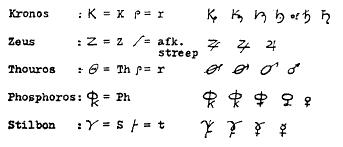The Origin of Gender Symbols in Biology
A quick post for International Women’s Day: how did the gender symbols originate in biology? What do ♀ and ♂ actually stand for?
The answer starts in antiquity, when planets and gods were almost synonymous. Religious rites (at least in Europe) were also associated with the working of metals. Thus, each heavenly body was associated with a metal, a god and provided with a proper symbol, thus:

1. Sun (gold) 2. Moon (silver) 3. Saturn (lead) 4. Jupiter (tin) 5. Mars (iron) 6. Mercury (mercury, duh) 7. Venus (copper) After woodcuts by Friz Kredel, published in Stearn 1962.
But how did the symbols of Mars (iron) and Venus (copper) migrate to describe sex in biology? It seems obvious to us that of all symbols, that of the god of war be assigned to male, and the goddess of love to female (stereotypes nonwithstanding), but who was the first who did that?
The answer can be traced to one of the greatest biologists of all times: Carl Linnaeus. He is better known for being the father of modern taxonomy: Linnaeus is the reason that we uniquely identify organisms using genus and species names in Latin grammatical form, a system known as Linneael binomial nomnclature. From Homo sapiens to Escherichia coli, we all owe our scientific names to Linnaeus.
But Linnaeus was also the one to appropriate the planet symbols to biology. In his notes, he used the Venus symbol as shorthand for female and the Mars symbol as shorthand for male. He also used Saturn to denote woody plants, the Sun for annual plants and Jupiter for perennials. As for gender, the Mercury symbol was used by Linnaeus for hermaphrodite plants. However, that symbol’s meaning has changed over the years, at least in scientific shorthand, and is now used to denote virgin female (e.g. in genetic analysis). Mars was also used by Linnaeus, somewhat confusingly, for biennial plants.
But how did the symbols actually originate? The accepted thought now is that they were derived by the Roman from the Greek initial letters for the planets / deities. So Phosphoros Φωσφόρος (Greek: “Morning Star” or later the planet Venus) was abbreviated to Φκ and Thouros (Mars) to θρ further contracted over the years, by metal workers, astrologers and alchemists to the modern symbols.

Kronos (saturn); Zeus (Jupiter); Thouros (Mars); Phosphoros (Venus) Stilbon (Mercury). After Stearn 1962
William T. Stearn (1962). The Origin of the Male and Female Symbols of Biology Taxon, 11 (4), 109-113



















The names of the planets can be traced back to at least 4000 BC, as the names of the days were derived from the names of the planets at that time. Sun = Sunday, Moon = Monday etc. The Vanir culture of that time kept records in picture form to accompany their oral tradition. The names of the days are ordered to reflect the speed of the planets’ movement in orbit. At the time, Saturday was the first day of the week. The symbols used have roots in the notations of the Vanir culture; these not only emerged as symbols for the planets, but their picture language survives in many areas today, such as the Rx symbol we use for drugstores and medicine appears 12,500 BC in the Magdalenian inscriptions, translating to “medicine lady and medicine.” See iceagelanguage.com, and Once Upon a Time: world of symbols blog.